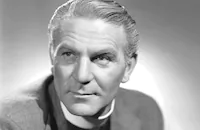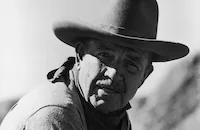The Last of the Mohicans

Brief Synopsis
Cast & Crew
George B. Seitz
Randolph Scott
Binnie Barnes
Henry Wilcoxon
Bruce Cabot
Heather Angel
Film Details
Technical Specs

Synopsis
In 1757, during the French and Indian War, British Colonel Munro and his daughters, Alice and Cora, are stationed at Fort William Henry, New York. Major Duncan Hayward, who is in love with Alice, arrives with orders to march against the French, but Magua, an Indian Army scout who is actually a French spy, sabotages the march and kidnaps Alice, Cora and Duncan. Hawkeye, a skillful Colonial scout who was reared by Mohawks, saves them with the help of Uncas and Chingachgook, the last men of the Mohican tribe. Uncas falls in love with Cora at first sight, while Hawkeye earns Alice's respect. When the group reaches the fort, they discover it is under attack by the French. Uncas is wounded attempting to get through enemy lines, and when some of the Colonialists desert, Hawkeye is unjustly jailed as a traitor. Just as the British reach honorable terms for surrender with the French, Magua leads an Indian attack and Colonel Munro dies nobly in the battle. Alice and Cora are captured by Magua, who wants Cora as his squaw and plans to burn Alice at the stake. Uncas frees Cora, but while being pursued by Magua, he falls from a cliff. Cora leaps after him, joining him in death. At the Indian camp, Hawkeye and Duncan are captured when they try to save Alice, and Magua offers Alice's life in exchange for Hawkeye's. Duncan disguises himself as Hawkeye, but is discovered, and the real Hawkeye is tied to the stake. The army arrives and Hawkeye is freed to face a court-martial, but the charges are dismissed when his true loyalty is disclosed. Hawkeye, now in love with Alice, returns to his duty with new purpose.

Director
George B. Seitz
Cast

Randolph Scott

Binnie Barnes

Henry Wilcoxon

Bruce Cabot

Heather Angel

Phillip Reed

Robert Barrat
Hugh Buckler
Willard Robertson
William Stack
Lumsden Hare
Frank Mcglynn Sr.
Will Stanton

William V. Mong
Art Du Puis
Ian Maclaren
Reginald Barlow
Olaf Hytton
Lionel Belmore
Claude King
Crew
John L. Balderston
Clem Beauchamp
John L. Cass
Jack Dennis
Philip Dunne
Paul Eagler
Wallace Fox
Harry M. Goetz
Ken Goldsmith
Edward P. Lambert
Harry Marker
Daniel Moore
Paul Perez
Robert Planck
Emile De Ruelle
John Ducasse Schulze
Harvey Shepard
Edward Small
Franc Smith
Edward Snyder
Roy Webb
Western Costume Company

Videos
Movie Clip



Hosted Intro
Film Details
Technical Specs

Award Nominations
Best Director
Articles
The Last of the Mohicans (1936)
Although Seitz (who directed several installments of MGM's wildly popular Andy Hardy series) brings Cooper's yarn to vivid life, a couple of filmmakers had already tackled the material before him. Theodore Marsden filmed a two-part version of the book way back in 1911, and Maurice Tourneur and Clarence L. Brown also shot an adaptation in 1920. There have been four other interpretations of Cooper's novel since then, with the most recent being Michael Mann's well-received 1992 version starring Daniel Day-Lewis. Some stories seem tailor made for the screen, regardless of the decade or changing audience tastes.
Scott delivers a credible performance as Hawkeye in Seitz's film, in part because he was careful to avoid looking foolish. There were reports that he was unhappy with some of the script's committee-written dialogue, especially the line, "I take my leave when the sun goes down behind yon hill." That line, and several others, were changed, thus saving Scott some embarrassment.
Although Seitz's film pretty much smacks of 1930s Hollywood, a surprising amount of care was taken in getting the little things right- including, oddly enough, the exact process of scalping an enemy combatant. The New York Times noted that research director Ed Lambert prepared for the picture by studying the Remington Schuyler painting, Custer's Last Stand, which depicts an ugly scalping in progressive stages. "There is nothing facetious in this matter," Lambert said, "the action must be correct in every detail to stave off the hordes of (mistake) hunters all over the country." The article also notes that Lambert interviewed the descendants of "this country's outstanding scalpers." That seems a bit above and beyond the call of duty, but, it has to be said, United Artists received no outraged letters from scalping enthusiasts.
A bit of interesting trivia concerning Scott: He was discovered by the young Howard Hughes, and must have learned a thing or two about handling money from the eccentric billionaire. After retiring from pictures in the 1960s, Scott was able to live on the fortune he had amassed from investing in oil wells, real estate, and securities. He was reportedly worth $50-$100 million, back when $1 million was considered a genuine fortune. Not too shabby for an old cowboy.
Producer: Edward Small, Harry M. Goetz
Director: George B. Seitz
Screenplay: Philip Dunne, John L. Balderston, Paul Perez, Daniel Moore (based on the novel by James Fenimore Cooper)
Cinematography: Robert Planck
Editing: Jack Dennis, Harry Marker
Music Director: Roy Webb
Art Designer: John DuCasse Schulze
Costume Design by: Franc Smith
Cast: Randolph Scott (Hawkeye), Binnie Barnes (Alice Munro), Heather Angel (Cora Munro), Hugh Buckler (Col. Munro), Henry Wilcoxon (Maj. Duncan Hayward), Bruce Cabot (Magua), Robert Barrat (Chingachgook), Philip Reed (Uncas), Willard Robertson (Capt. Winthrop), Frank McGlynn, Sr. (David Gamut), Will Stanton (Jenkins), William V. Mong (Sachem), Olaf Hytten (King George II).
B&W-91m.
by Paul Tatara

The Last of the Mohicans (1936)
Quotes
Trivia
Notes
The title card for the viewed print reads: "Harry M. Goetz Presents an Edward Small Production of James Fenimore Cooper's Classic of Early America." Film Daily reported on August 12, 1936 that in honor of this film's world premiere at Saratoga Springs, New York, George H. Bull, president of the Saratoga Racing Association, named various races after characters in the film, including Uncas, Hawkeye, the Mohican Handicap, the Chingachgook Handicap and the Magua Handicap. Film Daily also reported that the Loew's theater circuit opened the film on August 14, 1936. This film was shot at RKO-Pathé Studios as part of RKO's arrangement with United Artists. Location shooting included a principal unit under George Seitz at Sherwood Forest, CA, and a second unit, under the direction of Wallace Fox, in northern California and later at Cedar Lake in Big Bear, CA. According to Hollywood Reporter, an Eagle Boy Scout was hired to accompany the crew to Sherwood Forest, where he instructed Indian extras on how to start fires with flint and steel. Hollywood Reporter also states that actor Phillip Reed persuaded Harry Goetz to allow Harvey Shepard to act as his "whoops" stand-in after being advised by his vocal instructor that the raucous war whoops were injuring his voice.
A Hollywood Reporter ad for this film credits Paul Eagler, not Robert Planck, as both director of photography and special effects cameraman, and lists Roy Webb, who is credited on the film as music director, with the musical score. Copyright records list Nathaniel Shilkret as music director. Both of these men were musical directors at RKO at the time of this production. Ken Goldsmith was on leave from Republic at the time of this production, while George Seitz was under contract to M-G-M at the time. Early Hollywood Reporter production charts list Ralph Block with Philip Dunne as screenwriter, but Block does not appear in later production charts. According to Hollywood Reporter, Merle Oberon was originally set to star in this film. Juvenile actor David Scott, who was placed under contract to Edward Small in October 1935, was also scheduled to appear in this film; however, no information has been found to confirm his appearance in the final film. According to a Los Angeles Times news item on August 23, 1935, this film was originally going to be shot in Technicolor. According to an article in New York Times, Randolph Scott, who was borrowed from Paramount, tried to get out of playing Hawkeye because he believed it improbable that his character would speak the "flowery Cooper dialogue" called for in the script; Scott reportedly balked at the line, "I take my leave when the sun goes down behind yon hill," and finally was allowed to change some of his dialogue. According to Daily Variety, assistant director Jack Boland sued Reliance, Harry Goetz, Edward Small, Morris Small and research director Ed Lambert for $2,000, which he claimed was due as salary for his directing services following a fifty percent paycut of his $250 weekly salary during production. No other sources verify Boland's work on this production, however, and it is unclear what, if any, contributions he made to the film.
A New York Times article notes that Lambert relied on the Remington Schuyler painting "Custer's Last Stand," which portrays several scalpings in progressive stages, to make the scalping scenes as authentic as possible. Lambert is quoted as saying, "There is nothing facetious in this matter...the action must necessarily be correct in every detail in order to stave off the hordes of boner-hunters all over the country." Lambert also consulted the descendants of what New York Times referred to as "this country's outstanding scalpers." According to Film Daily, Goetz offered a personal prize of one-hundred dollars for the best exploitation campaign for this film. A news item in Film Daily on August 25, 1936 states that B. E. Fry of the Loew's Vendome theater in Nashville hired two Western Union boys to carry a six-foot telegram addressed to the mayor, inviting him to the film's opening, through the city's streets to City Hall.
Cooper's novel was also the source of the following productions: the 1920 Maurice Tourneur film of the same title, directed by Tourneur and Clarence L. Brown, and starring Wallace Beery and Barbara Bedford; a 1947 Columbia film entitled Last of Redmen, directed by George Sherman and starring Jon Hall; a 1950 United Artists production entitled The Iroquois Trail, directed by Phil Karlson and starring George Montgomery and Marian Thorne; an eight-part BBC production aired in 1971, directed by David Maloney and starring Patricia Maynard, Tim Goodman and Kenneth Ives; a 1977 television movie, directed by James L. Conway and starring Steve Forrest and a 1992 Twentieth Century-Fox release, directed by Michael Mann, and starring Daniel Day-Lewis and Madeleine Stowe. The 1992 film was partially based on Philip Dunne's screenplay.

Miscellaneous Notes
Released in United States 1936
Based on the novel "The Last of the Mohicans" written by James Fenimore Cooper and published in 1826.
Released in United States 1936














